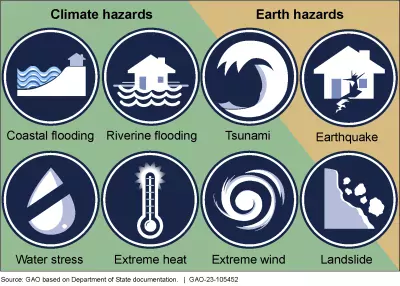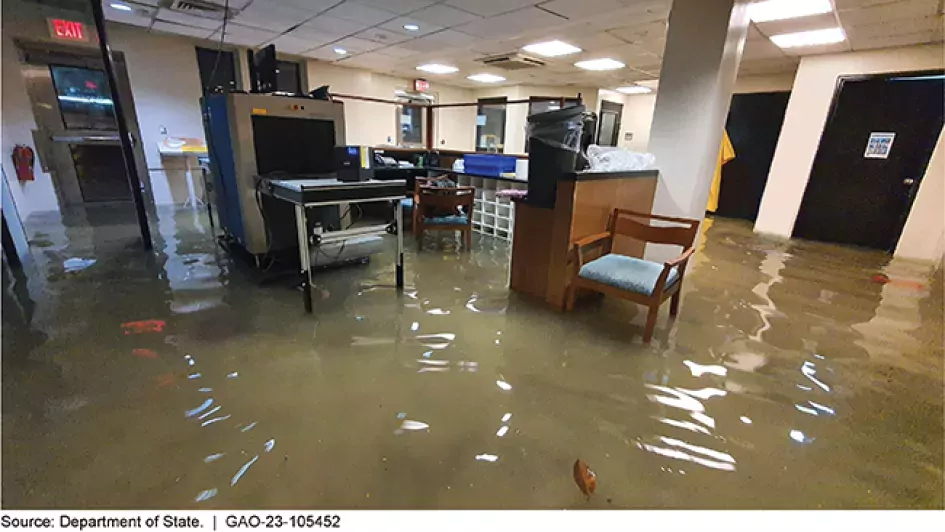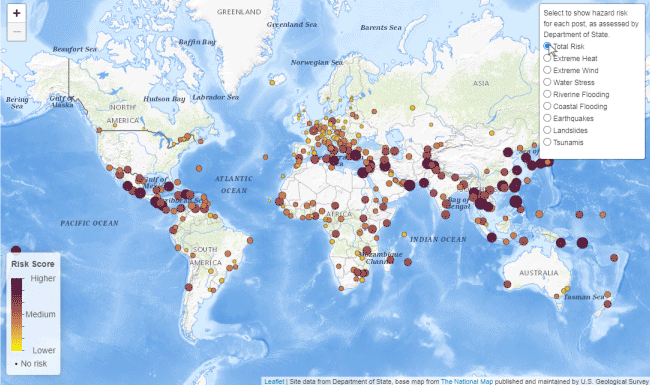Climate Hazards Could Disrupt U.S. State Department Operations Overseas (interactive map)
The increasing frequency and severity of natural hazards—including those linked to climate change— has heightened the risk of disruption to the Department of State's operations overseas. This includes embassies and consulates, office buildings and support facilities that serve diplomatic efforts, as well as staff residences housing U.S. employees. Department of State’s (State's) overseas assets include more than 90,000 personnel and properties valued at approximately $70 billion in over 290 locations.
Today’s WatchBlog post looks at our new report on how State assessed natural hazard risks to its posts and what those risks mean for future embassy construction and operations. You can also check out our video below to learn more.
Our new interactive map, linked below, shows the total risk each post faces from all natural hazards, as well as which posts are at high risk for individual hazards.
What are the risks?
State officials have identified eight natural hazards that could affect its posts. Most of these hazards are attributable to, or exacerbated by, climate change. These hazards include everything from coastal flooding to extreme wind. Some of State’s assets are at risk from multiple natural hazards, raising the potential for damage and disruption to operations.
Image

Which posts are at the most risk?
Data collected by State for its risk assessment suggest that about half of the 32 posts at highest total risk to negative impact from natural hazards are located in East Asia and the Pacific. These posts are also at high risk across several individual hazards. No posts in sub-Saharan Africa are in the highest risk category. Of note, the post at highest risk is the U.S. embassy in Manila, Philippines. It has experienced flooding from heavy rainfall as recently as August.
Flooding at U.S. Embassy in Manila, Philippines in August 2022
Image

How does State assess risk?
State released a Climate Adaptation and Resilience Plan in 2021 that outlines priority actions needed to protect the health and safety of personnel and adapt facilities, operations, and mission-critical services to be more resilient to these hazards. As a first step, State completed an assessment of natural hazard risks to all its 294 posts in May. Natural hazard risk includes not only exposure to any of the eight natural hazards, but also the severity of potential damage to facilities and the vulnerability of assets to disruption, such as facility age or access to potable water and sanitation. For example, an older facility located in a coastal area would be at higher risk of severe impact from flooding and extreme wind experienced during a hurricane than a newer facility located further inland.
We have planned future work for 2023 that will look at State’s efforts to address natural hazard resilience of its new and existing facilities overseas.
Want to learn more about our work on U.S. diplomatic presence abroad or the federal response to climate change? Read our other blogs on the Department of Defense’s Climate Change Adaptation and Federal Climate Resilience. Also check our key issues page on Diplomatic Presence and Management or our high-risk page on Federal Management of Climate Change Risks.
- Comments on GAO’s WatchBlog? Contact blog@gao.gov.
GAO Contacts
Related Products

GAO's mission is to provide Congress with fact-based, nonpartisan information that can help improve federal government performance and ensure accountability for the benefit of the American people. GAO launched its WatchBlog in January, 2014, as part of its continuing effort to reach its audiences—Congress and the American people—where they are currently looking for information.
The blog format allows GAO to provide a little more context about its work than it can offer on its other social media platforms. Posts will tie GAO work to current events and the news; show how GAO’s work is affecting agencies or legislation; highlight reports, testimonies, and issue areas where GAO does work; and provide information about GAO itself, among other things.
Please send any feedback on GAO's WatchBlog to blog@gao.gov.






